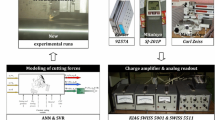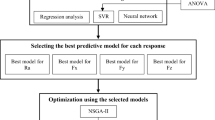Abstract
Slow tool servo (STS) turning is superior in machining precision and in complicated surface. However, STS turning is a complex process in which many variables can affect the desired results. This paper focuses on surface roughness prediction in lenses STS turning. An exponential model, based on the five main cutting parameters including tool nose radius, feed rate, depth of cut, C-axis speed, and discretization angle, for surface roughness prediction of lenses is developed by means of orthogonal experiment regression analysis. Meanwhile, a prediction model of surface roughness based on least squares support vector machines (LS-SVM) with radial basis function is constructed. Orthogonal experiment swatches are studied, and chaotic particle swarm optimization and leave-one-out cross-validation are applied to determine the model parameters. The comparison of LS-SVM model and exponential model is also carried out. Predictive LS-SVM model is found to be capable of better predictions for surface roughness and has absolute fraction of variance R 2 of 0.99887, the mean absolute percent error e M of 8.96 %, and the root mean square error e R of 10.68 %. The experimental results and prediction of LS-SVM model show that effects of tool nose radius and feed rate are more significant than that of depth of cut on surface roughness of lenses turning.
Similar content being viewed by others
References
Kim HS, Lee KI, Lee KM, Bang YB (2009) Fabrication of freeform surfaces using a long-stroke fast tool servo and corrective figuring with on-machine measurement. Int J Mach Tools Manuf 49(12–13):991–997
Sosnicki O, Pages A, Pacheco C, Maillard T (2010) Servo piezo tool SPT400MML for the fast and precise machining of free forms. Int J Adv Manuf Technol 47(9–12):903–910
Liu Q, Zhou X, Xu P, Zou Q, Lin C (2012) A flexure-based long-stroke fast tool servo for diamond turning. Int J Adv Manuf Technol. doi:10.1007/s00170-011-3556-3
Yu DP, Hong GS, Wong YS (2012) Profile error compensation in fast tool servo diamond turning of micro-structured surfaces. Int J Mach Tools Manuf 52(1):13–23
Bang YB, Lee KM, Oh S (2005) 5-axis micro milling machine for machining micro parts. Int J Adv Manuf Tech 25:888–894
Yan JW, Zhang ZY, Kuriyagawa T, Gonda H (2010) Fabricating micro-structured surface by using single-crystalline diamond endmill. Int J Adv Manuf Tech 51(9–12):957–964
McCall B, Tkaczyk TS (2010) Fabrication of plastic microlens array for array microscopy by three-dimensional diamond micromilling. Opt Eng 49(10):103401
Wu YL, Pen WQ, Liu Y (2012) A novel fabrication method for micro optical waveguide mold based on fly-cutting technology. Int J Light Electron Opt. doi:10.1016/j.ijleo.2012.02.020
Kong LB, Cheung CF (2011) Prediction of surface generation in ultra-precision raster milling of optical freeform surfaces using an Integrated Kinematics Error Model. Adv Eng Softw. doi:10.1016/j.advengsoft.2011.09.011
Yin ZQ, Dai YF, Li SY, Guan CL, Tie GP (2011) Fabrication of off-axis aspheric surfaces using a slow tool servo. Int J Mach Tools Manuf. doi:10.1016/j.ijmachtools.2011.01.008
Chen CC, Cheng YC, Hsu WY, Chou Y, Wang PJ, Tsai DP (2011) Slow tool servo diamond turning of optical freeform surface for astigmatic contact lens. Proc SPIE 8126, Optical Manufacturing and Testing IX, 812617 doi:10.1117/12.892447
Li L, Yi AY (2009) Microfabrication on a curved surface using 3D microlens array projection. J Micromech Microeng. doi:10.1088/0960-1317/19/10/105010
Li L, Yi AY (2010) Development of a 3D artificial compound eye. Opt Express 18(17):18125–18137
Hsu WY, Liu YL, Cheng YC, Kuo CH, Chen CC, Su GD (2012) Design, fabrication, and metrology of ultra-precision optical freeform surface for progressive addition lens with B-spline description. Int J Adv Manuf Tech. doi:10.1007/s00170-012-3901-1
Zhang XD, Fang FZ, Wu QQ, Liu XL, Gao HM (2012) Coordinate transformation machining of off-axis aspheric mirrors. Int J Adv Manuf Tech. doi:10.1007/s00170-012-4642-x
Zhang XD, Fang FZ, Wang HB, Wei GS, Hu XT (2009) Ultra-precision machining of sinusoidal surfaces using the cylindrical coordinate method. J Micromech Microeng 19(5):054004
Li L, Collins SA Jr, Yi AY (2010) Optical effects of surface finish by ultraprecision single point diamond machining. ASME J Manuf Sci Eng 132(2):021002
Cheung CF, Lee WB (2000) A theoretical and experimental investigation of surface roughness formation in ultra-precision diamond turning. Int J Mach Tools Manuf 40(7):979–1002
Lee WB, Cheung CF, To S (2007) Multi-scale modeling of surface topography in single-point diamond turning. J Achiev Mater Manuf 24(1):260–266
Fang XD, Safi-Jahanshaki H (1997) A new algorithm for developing a reference model for predicting surface roughness in finish machining of steels. Int J Prod Res 35(1):179–197
Feng CX, Wang X (2002) Development of empirical models for surface roughness prediction in finish turning. Int J Adv Manuf Tech 20:348–356
Özel T, Karpat Y (2005) Predictive modeling of surface roughness and tool wear in hard turning using regression and neural networks. Int J Mach Tools Manuf 45(4–5):467–479
Xu WJ, Wei ZF, Sun J, Wei L, Yu ZY (2012) Surface quality prediction and processing parameter determination in electrochemical mechanical polishing of bearing rollers. Int J Adv Manuf Tech. doi:10.1007/s00170-011-3891-4
Salgado DR, Alonso FJ, Cambero I, Marcelo A (2009) In-process surface roughness prediction system using cutting vibrations in turning. Int J Adv Manuf Tech. doi:10.1007/s00170-008-1698-8
Zhang LX, Jia ZY, Wang FJ, Liu W (2010) A hybrid model using supporting vector machine and multi-objective genetic algorithm for processing parameters optimization in micro-EDM. Int J Adv Manuf Tech. doi:10.1007/s00170-010-2623-5
Kennedy J, Eberhart RC (1995) Particle Swarm Optimization. Proc of the IEEE Int Conf on Neural Networks (Perth, Australia), IEEE Service Center, Piscataway, NJ, 4, 1942–1948
Shi Y, Eberhart RC (1998) A modified particle swarm optimizer. Proc of the IEEE Int Conf on Evolutionary Computation. Anchorage, USA, 69–73
Liu B, Wang L, Jin YH, Tang F, Huang DX (2005) Improved particle swarm optimization combined with chaos. Chaos Soliton Fract 25(5):1261–1271
Author information
Authors and Affiliations
Corresponding author
Rights and permissions
About this article
Cite this article
Wang, X., Kang, M., Fu, X. et al. Predictive modeling of surface roughness in lenses precision turning using regression and support vector machines. Int J Adv Manuf Technol 87, 1273–1281 (2016). https://doi.org/10.1007/s00170-013-5231-3
Received:
Accepted:
Published:
Issue Date:
DOI: https://doi.org/10.1007/s00170-013-5231-3




